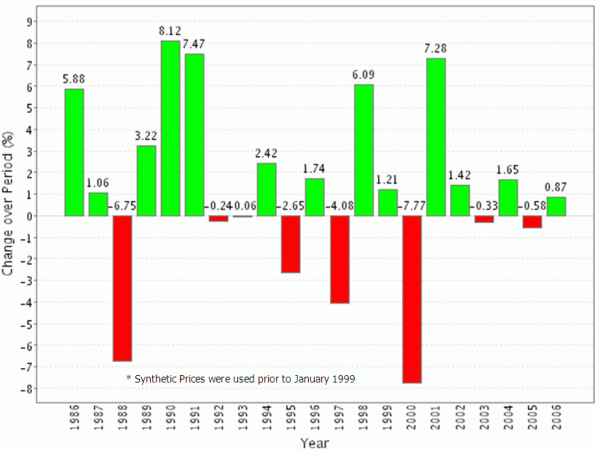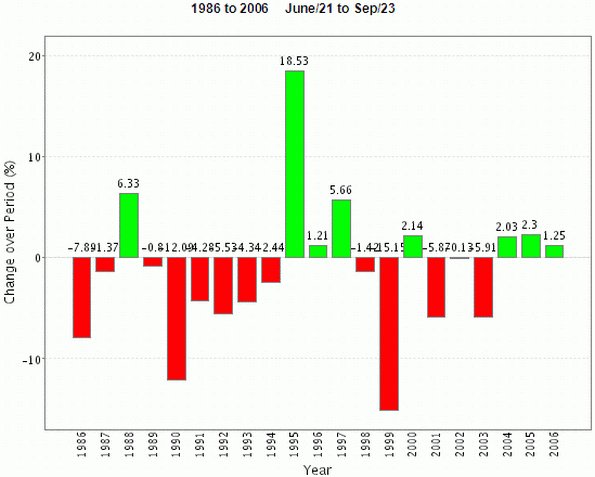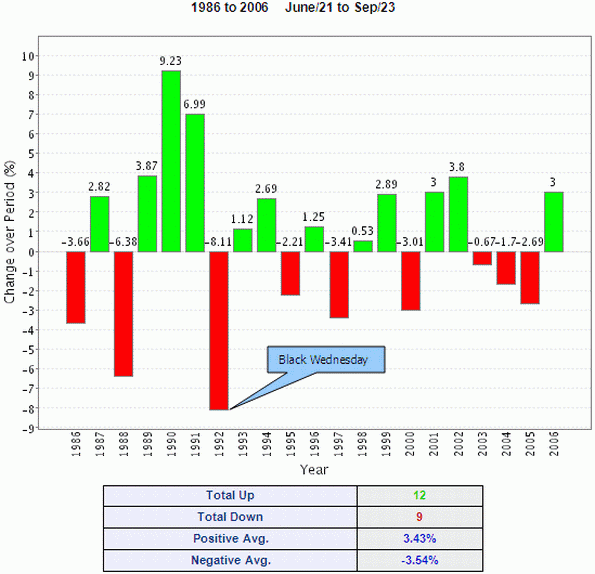| Is Seasonality in the Currency Markets Responsible for the Dollar's Slide? |
| By Antonio Sousa |
Published
07/13/2007
|
Currency
|
Unrated
|
|
|
|
Is Seasonality in the Currency Markets Responsible for the Dollar's Slide?
The US dollar is trading at a record low against the Euro and everyone from traders to analysts will agree that the latest wave of selling was triggered by renewed concerns about the housing market and more specifically, the sub-prime sector. However the problems in housing may not be the only factor driving the dollar lower.
However the problems in housing may not be the only factor driving the dollar lower. Based upon our seasonality study, we have found that even when there are no major problems in the US economy, the dollar has a greater tendency to fall than rise during the summer trading months. Seasonality studies have long been one of the favorite indicators among futures traders, but despite the fact that seasonal trends do form in the FX market, this type of study is largely overlooked by currency traders.
In this article, we argue that the summer seasonal effect in the FX market is stronger than just a drop in both trading volume and price volatility. We define summer as the time between June 21st the first day of summer in the Northern Hemisphere and September 23rd, the first day of autumn. Now that the EUR/USD is trading above 1.3750, there is some evidence that 2007 might mirror historical seasonal trading patterns. In fact, since 1999, when the single currency was officially launched, the EURUSD has appreciated 5 out of the past 8 years.
Euro – US Dollar (EUR/USD)
Taking a longer term look at seasonality, we found that over the past 21 years, from June 21st to September 23rd, the euro appreciated against the U.S. dollar 13 times, which is roughly 62 percent of the total sample (Synthetic euro prices were used prior to January 1999). Moreover, the euro gained on average, 3.73 percent during the positive months and lost only 2.81 percent during the negative months. Although the seasonality impact is small, the bias is there. The summer has just begun and the combination of seasonality and growing problems in the US economy could drive the EUR/USD close to 1.40 before the end of the summer. There are many reasons that could help us understand why this historical tendency exists but one possible explanation may be international tourism. Summer is often a time of the year when many people choose to go on vacations, and since France, Spain or Italy remains attractive travel destinations for many Americans, the higher level of demand for european goods places upward pressure on the value of the euro.


US Dollar – Japanese Yen (USD/JPY)
The seasonal effect can also be seen in the value of the US dollar against the Japanese Yen. Like the Euro, over the past 21 summers, the US dollar depreciated against the yen 13 times. Moreover, the yen gained on average, 5.17 percent during the positive months, and lost 4.93 percent during the negative months. The average loss is skewed by a big drop in 1995 when Japan suffered the consequences of the Great Hanshin Earthquake. More than 5,500 people were killed, over 26,000 injured, and the country lost an estimated 200 billion US dollars.


British pound – US Dollar (GBP/USD)
The seasonal effect of the summer on the sterling is positive but not as significant as the one found in both the euro and Japanese yen. Over the past 21 years, from June 21st to September 23rd, the GBPUSD appreciated during just 12 of the last 21 years, which is roughly 57 percent of the total sample. The sterling gained on average 3.43 percent during the positive months but lost 3.54 percent during the negative months. The British pound lost the most during the summer of 1992, when the British government was forced to withdraw the Sterling from the European Exchange Rate Mechanism, a day know as Black Wednesday.

Conclusion
Taking seasonality into consideration is an important exercise for all traders. In the case of the US dollar, we can see that problems in the sub-prime sector may not be the only factor that is driving the dollar lower over the past few weeks. If seasonality is also one of the reasons why dollar selling has taken place, then a recovery may be in store in the fourth quarter. Of course seasonality would not be the only factor needed to drive a recovery because the seasonality bias is small, but this would be aligned with the Federal Reserve’s overall belief that the US economy will rebound in the second half of the year as exports are boosted by the weakness of the US dollar.
Antonio Sousa is a Currency Analyst for FXCM.
|